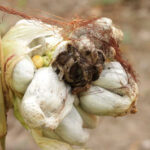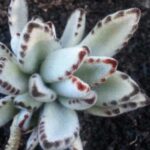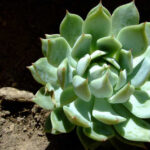The radicchio plant is part of a much larger chicory family, known for its crunchy leaves in recipes like a salad with blue cheese, or even roasted with olive oil and salt. Its family is also known for its famous roasted and dried roots that can be made into a coffee alternative. But these jolly little heads of somewhat bitter leaves are marvelous crops to have in the garden. Able to keep in storage longer than many other lettuce plants, this addition to the garden rotation would be well worth it!
A member of the Compositae family like the endive, it is originally from Eurasia and North Africa. It has since spread around the world and even has a wild cousin that grows across several western US states with bright blue stalks of flowers that float to almost 4 feet in height.
A great plant to direct sow, this easy-to-grow crop is a wonderful starter plant for any home gardener. Able to tolerate a first or last frost if mature, these plants are wonderfully hardy not to mention wonderfully beautiful!
Quick Care Guide

| Common Name(s) | Italian Chicory, Chioggia, Trevisio, Radicchio, Radichetta |
| Scientific Name | Cichorium intybus var. foliosum |
| Days to Harvest | 55-70 days |
| Light | Full sun to part shade |
| Water | 1-2 inches; keep plant evenly moist |
| Soil | Well draining rich soil; sand to clay |
| Fertilizer | 10-10-10 |
| Pests | Aphids, ants, thrips |
| Diseases | Powdery mildew, downy mildew |
All About Radicchio
Radicchio is a peppy cool-weather-loving plant that livens up salads and roasts! Grown primarily as a cool-weather crop, these colorful little plants are known for their bitter flavor and lovely round shape. These plants can at first look a bit like cabbage, but radicchio, or Cichorium intybus var. foliosum is actually more closely related to the boat-shaped endive than cabbage.
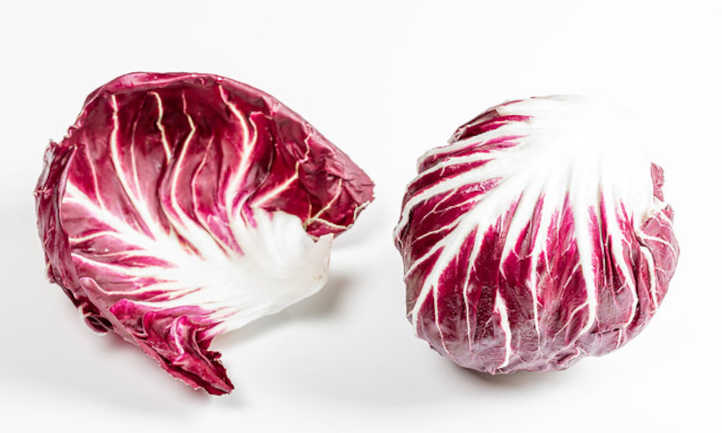
Most radicchio plants usually grow to about .5-1’ in height and form a clumping mass of leaves that make up the radicchio head. Radicchio grows green leaves that can turn a deep red when the weather and soil temperatures are cool enough, although some varieties are always green in color. Most leaves are curved or cuplike with white midribs radiating throughout the leaf. While the outer leaves may remain large and flop on their sides, it is the center of the radicchio that forms the entire head in its customary rounded shape.
Radicchio has a strong preference for cooler weather, which is why this is such a wonderful fall harvest. During hot weather, radicchio tends to turn bitter and then bolt, sending out a long stalk of increasingly smaller leaves and eventually off-white daisy-like flowers.
Best planted in the fall, this crop can tolerate some heat and frost but prefers the cooler air temperatures of fall and early spring. Before planting, check for your first frost date if sowing seeds in the fall, or for your last frost date if in the spring. The mature plants can tolerate frost, but seedlings cannot. Sow seeds with 60+ days of good weather on the horizon. Radicchio grows quickly from seed and can be direct sown or transplanted.
Radicchio grows from a central taproot like many other lettuces. Additional radiating roots grow horizontally right underneath the soil level. This shallow-rooted system is responsible for most of the plant’s water and nutrient uptake during the growing season.
Most radicchio grows quickly from just a few seeds, sprouting in just about a week. Within two months most have reached their mature size. First, they form somewhat messy leafy clumps and send their leaves out. With time, the inner leaves develop into their classic round shape. They begin to bolt or go to seed when left too long in the ground, or when warm weather approaches in late spring. While they can become too bitter at this stage to enjoy eating, they begin to flower in order to reproduce. Let this process happen, and the flowers will turn into seeds to collect for next year’s harvest! Alternately, leave the flowers for pollinators to enjoy.
Types of Radicchio
Radicchio can generally be found growing in three different types of growth habits. The first is the more famous Chioggia type which develops a rounded head. This type includes the Radicchio Rosso which is the most common variety commonly found in stores. The second type is the elongated type, where the leaves grow in an ovular cup shape. This variety includes the spectacular Radicchio di Treviso with thick white ribs and dark red almost magenta leaves.
There are also loose-leaf varieties, although these are much rarer. Seed selection in general for radicchio isn’t as tight as it is with other more common garden vegetables, so expect more variety from your seed packets when you sow radicchio. If interested in growing one of these heirloom varieties, try Radicchio Castelfranco – a loose-leaf green and red polka-dotted variety that is sure to add some interest to your spring crops harvest!
Planting Radicchio
Radicchio is a great option for container gardening, or for your first foray into growing from seed. A shallow-rooted crop that needs moist soil, try growing your plants in an area that is either in full shade in the fall and early spring, or in partial shade if temperatures get over 70 degrees.
You can start seeds about a month before your last frost to help extend your growing season, and have plants to transplant out as soon as the weather allows. Seedlings can die from a first or last frost that their mature selves can weather, so start several rounds of radicchio seed to ensure a sufficient crop.
If direct sowing your crops, you’ll need well-drained soil that is rich in aged compost or another nitrogen-rich fertilizer. Place your radicchio seeds about 3-4” apart at a depth of 1/4”-1/2” deep in rows that are spaced about two feet apart. Remember, a good way to gauge how deep your seed should be planted is to sow it at twice the depth of the seed’s width.
Once your plants are about 2” tall, you can thin them (or transplant them out) at a distance of about 10” apart, and then add mulch to keep the soil evenly moist.
Care
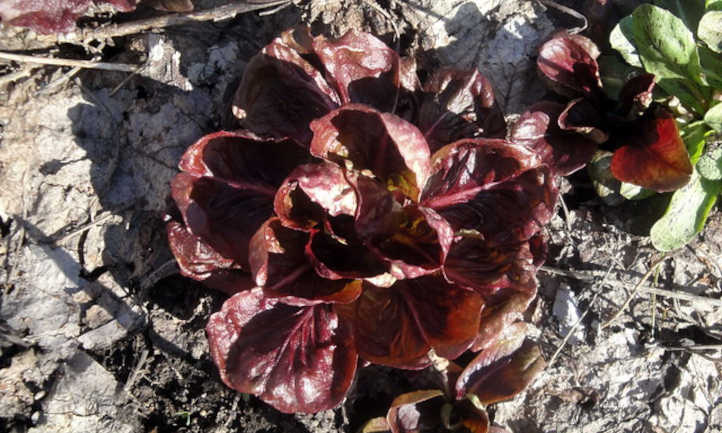
Radicchio is a pretty easy vegetable to grow, it has a few needs that once met, almost guarantee success in the garden! Be sure to get it off to a good start, and it will pretty much take care of itself until harvest.
Sun and Temperature
Radicchio plants love sunlight, but not too much heat. While it can tolerate full sun to light shade, keep in mind the ambient temperature of your garden. If growing in the spring as the weather warms up, plant in afternoon shade as the days warm. In fall, plant in full sun as the days cool down. As radicchio only needs about 3 hours of sunlight a day, you can be flexible with where to sow this vegetable!
Mature radicchio can tolerate a light frost or a few warm days, but it’s best grown in the mild weather days between summer and winter. A prolonged frost might kill it. Conversely, a prolonged heat spell can cause the leaves to burn, or the radicchio to turn bitter. Depending on what zone you’re in, you can grow it through the winter for a winter harvest (think USDA zones 9-11).
Water and Humidity
Radicchio plants are moisture-loving! These plants don’t tolerate dry periods whatsoever, so be sure to install a drip or soaker system, or have a solid watering plan in place before bringing radicchio into your garden.
Radicchio plants are best watered in the morning, and given sufficient time to absorb the water and let it settle before the heat of the day arrives. If you’re planting in a sunny area or need to conserve water for any reason, a good way to keep your soil moist is by adding mulch to the soil directly around your plant at a depth of 1-2 inches, this will help keep your seedling’s roots evenly moist.
The best way to deliver water to radicchio is through the use of drip irrigation. This prevents molds by watering directly at the root line and helping water be delivered right where it needs to go. Clear out any water-sucking weeds from the area. Radicchio needs 1-2” of water a week. If in doubt about whether your plants need more water, do a finger test. Simply poke a finger into the soil at least 2-3 inches deep, then pull out your finger. If you can feel moisture, you don’t need to water. If your finger comes out bone dry, the radicchio needs to be watered.
Soil
Radicchio isn’t very particular about the type of soil it’s grown in. It can tolerate sandy, clay, or anything in between when it comes to soil type. It does need soil that has been amended with either compost or other rich organic material. Additionally, it does need drainage as well.
While tolerant of a wide range of soil pH, it thrives in-ground with a soil pH between 6.0 and 6.8.
Fertilizing
Like all cool weather leafy greens, radicchio needs a generous amount of nitrogen. Nitrogen fuels leaf growth and as you grow radicchio for its leaves, it needs applications of nitrogen while growing. This can either be as a simple fertilizer or from the compost worked into the soil at the time of planting.
Applications of phosphorus and potassium help with root development and all-over growth. This is best given at the time of sowing or transplanting. Try using a 10-10-10 balanced fertilizer for this. A slow-release granular works best in sandy soils, and a liquid option is better for clay soils.
Pruning
Radicchio grows in a mounded clump with several floppy large leaves at the base of the plant. These large and floppy leaves can present a problem in that they touch the ground and spread diseases from the soil. Try clipping back a few of these that touch the ground.
Propagation
Radicchio is very easy to grow from seed. With a germination time of around a week, you’ll have seedlings in no time!
Harvesting and Storing

Like with most salad greens, if you’re growing radicchio, you’re probably growing radicchio to have fresh salads for your early fall or spring dinner table. With that in mind, remember that radicchio won’t last as long as some other vegetables.
Harvesting
Your radicchio should be harvested as soon as the heads reach a usable size. You can either harvest heads whole, or harvest the outer leaves and keep going for multiple harvests.
To harvest, hold onto the ‘head’ or ‘heart’ of the plant, and twist the entire plant out of the ground. Then, cut off the root system with cutters or a serrated knife and remove any outer leaves that are damaged. You should be left with a nicely shaped head of radicchio.
Storing
Radicchio will last longer than run-of-the-mill iceberg lettuce. When carefully stored in a cool ventilated area, it can last up to two months without refrigeration if you avoid overcrowding! If you store it in a perforated plastic bag in the refrigerator, your winter harvest can be prolonged. If you grow radicchio late enough, you can enjoy this fall crop and tasty radicchio harvest into the winter!
Troubleshooting

There are a few problems that might hinder the perfect harvest. By planning ahead of time with the right varieties of radicchio, keeping your soil moist with mulch and minimal weed growth, and encouraging good air circulation you can prevent problems before they start!
Growing Problems
The most common problem associated with growing radicchio is its bitter flavor once it’s begun to bolt. This is fairly common in the spring as warmer temperatures arrive. Radicchio growing involves some weather divination that’s for sure, but you can help prevent your plant from bolting by sowing bolt-resistant seeds. Proven bolt-resistant varieties such as ‘Giulio’ & ‘Silla’ are great seeds to try.
Pests
Like with other lettuce crops, radicchio can be attacked by a few small pests that come along and chomp on its leaves. You might not spot the bugs doing the attacking, but you can see their damage, many holes in your otherwise healthy radicchio head! Much of this damage can be caused by flea beetles, aphids, or cabbage loopers. Use insecticidal soap to eliminate these pests, or as a stronger option, pyrethrin. BT is extremely effective against cabbage loopers. Alternatively, use a barrier like a row cover to physically keep insects away from your plants.
Ants can sometimes show up uninvited in your radicchio patch, and while they themselves don’t target your plants, they can often bring other pests like aphids that will. Organic ant baits are effective ways of eliminating them, but better is to keep the soil consistently moist. Ants don’t like their homes damp.
Diseases
Radicchio plants can sometimes fall prey to mildews. These diseases thrive on moist leaves, a lack of air circulation, and not enough direct sunlight. When they do appear, either by displaying white powdery spots on their leaves as is the case with powdery mildew or as grey mold and speckling of the leaves with downy mildew, apply a fungicide to stop growth.
When it comes to molds or bacterial leaf spot in the garden, the best medicine is prevention. Try to fight off these, and other diseases like bacterial disease or black rot by always planting in well-draining soil, watering in the morning, avoiding getting the foliage wet, avoiding over planting and overcrowding your heads of radicchio, and keeping down weeds. Prevention is stronger than any fungicide.
Frequently Asked Questions
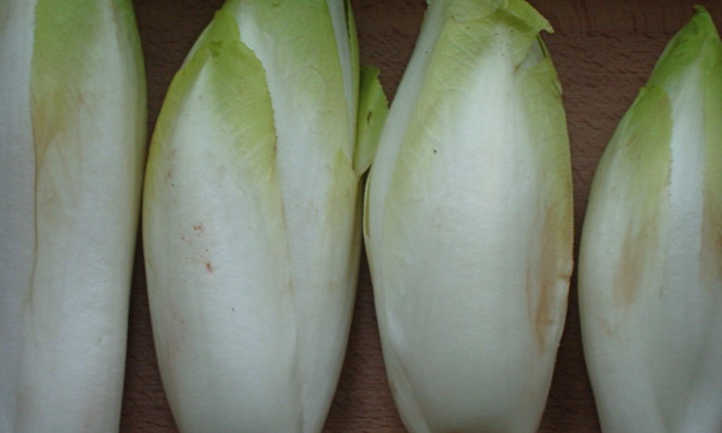
Q: Is radicchio hard to grow?
A: Not at all!
Q: Is radicchio a perennial?
A: Not really. It can be grown as a perennial, but few do.
Q: Can you eat bolted radicchio?
A: It isn’t poisonous, but it isn’t as enjoyable as radicchio before it bolts. If you eat this, expect a very bitter and tough plant.

